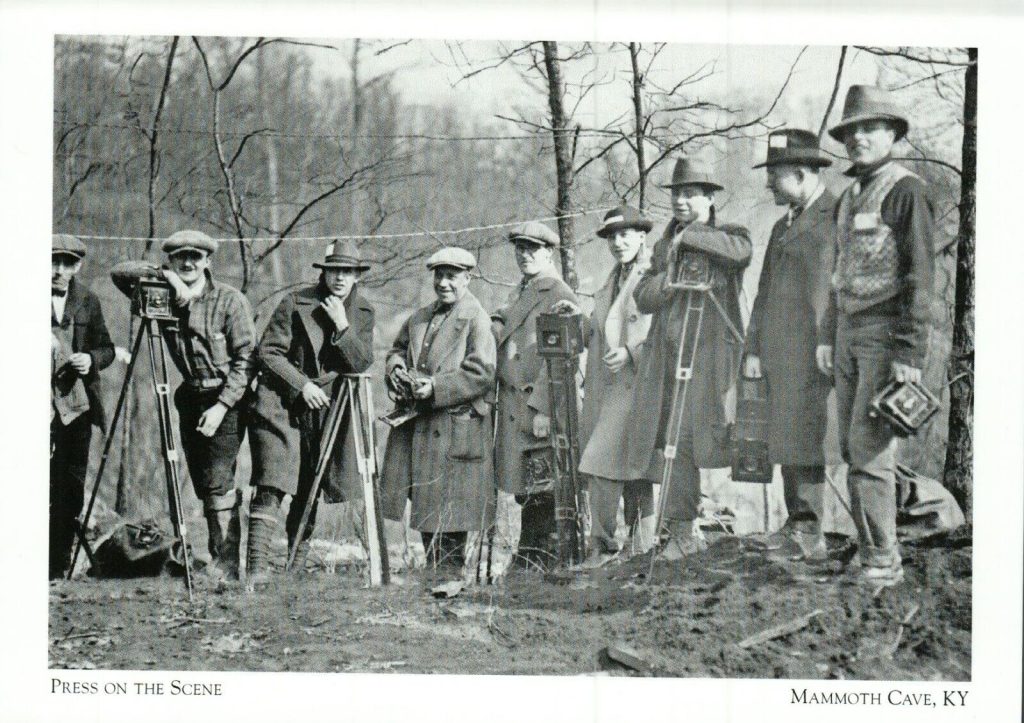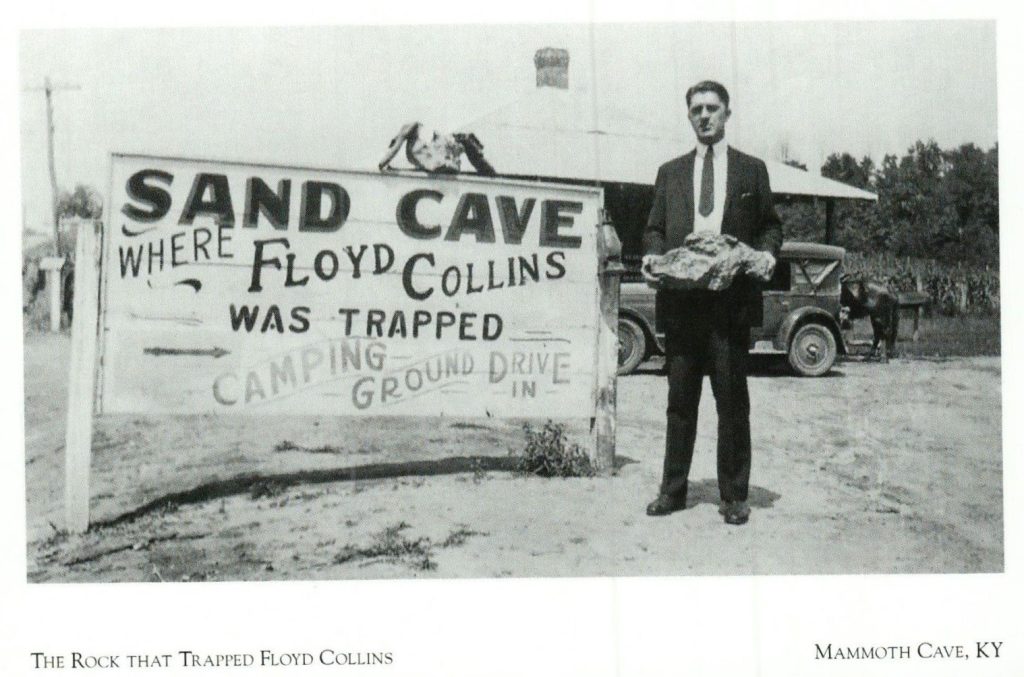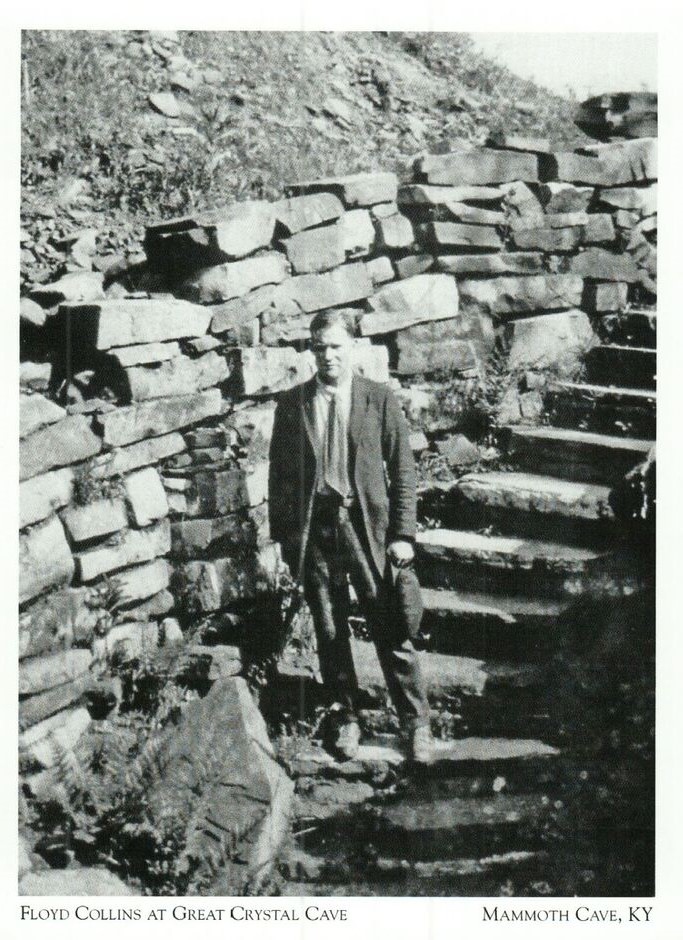On January 16, 1920, when a Federal Enumerator of the 14th census of the United States of America, James H. Martin, from Kentucky, visited the Collins farm in Parker Township, Kentucky, he found Leonidas “Lee” Collins and his three children, Floyd, Nellie, and Homer and their stepmother Serilda. Martha Jane (nee, Barrett) Collins, Lee’s first wife and mother of his three children died in 1915.

One section of the 1920 census form concerned each citizen’s education. Sadly, Serilda could neither read nor write, but her husband and stepchildren answered, yes, they could do both. Another section of that census asked what occupation each citizen had. Mr. Collins and his son Floyd answered that they were farmers. No mention of cave exploring was mentioned.
Yet, only five years later, Floyd was recognized as, “the greatest cave explorer ever known.” These very words are carved into his headstone. Significant to the story of Floyd Collins is that he died before he became famous.
Floyd received recognition after being trapped in the Sand Cave near Cave City, Kentucky. He was attempting to enlarge the opening of a newly discovered cave to accommodate tourists.
On January 30, 1925, Collins was trapped in a cave with his leg pinned under a rock that had fallen from the roof of the cave. He was 55 feet below ground. The only contact with Collins was accomplished by a young newspaper reporter, William Burke Miller, working for the Louisville Courier-Journal, who crawled through a narrow tunnel toward Collins, taking water, food, and encouragement with him. Miller was a slight-of-stature individual of just 5′ 5″ that enabled him to make that dangerous daily journey. Collins’s dilemma gained national interest as Miller submitted his daily reports to his editor. Miller’s story was soon picked up by the wire services and shared with dozens of syndicated newspapers.
On the fourth day, more of the tunnel fell and blocked the small passageway. Miller and Collins could only communicate from a distance.
On day six – February 5th Miller filed his daily report that began:
… a solitary figure stood in the glow of a hill-top campfire last night watching silently the shaft being sunk inch by inch to Floyd Collins. The light’s reflection revealed, after a minute, two streams of tears on the watcher’s face, but they were never brushed away.
This silent observer was Alma Clark, 22 years old, living eight miles from Cave City, come to mourn on what was to have been her wedding day and for him who was to have been her husband. She stood alone as scores of workmen exerted themselves to force a way through rock and earth into the cavern.
Around her many were talking. They didn’t know, they didn’t even see this figure nor did she see them. Then she turned finally, and in a moment was lost in the darkness.
Her tears, her expression, and her walk told plainly that her hopes are no more.
Floyd Collins and Miss Anna Clark were to have eloped today, but only a few of their friends knew their secret.
Louisville Courier-Journal, Friday, February 6, 1925, Page 1.
This situation never improved and continued into the next two weeks. After no further communication from Collins for three days, the rescue team reached his lifeless body on February 16. His exact death date is not known. He was 37 years old.
[On May 4, 1926, Miller was awarded the Pulitzer Prize in journalism for his diligent reporting. This included a $1,000 monetary prize. Deciding to leave journalism, he used the money to start selling ice cream in Florida. Within a short time, he attempted a new career in journalism when the New York World offered him a position, but he failed to meet his employer’s goals and again left journalism for radio broadcasting job where his specialty became on-location live broadcasting of special events. Near the end of the 1930s, he did a live report at the same time he made his first parachute jump. Robert Ripley, of “Ripley’s Believe It or Not” fame, labeled him as “the bravest man in radio.” From then and into the 1940s he did voice-over public service announcements. There is no evidence of it, but the Collins story may have haunted Miller for the rest of his life and even afterward – the facts of the event are inscribed on the back of his tombstone in Danby, Vermont.]
The media coverage of this ordeal was extensive, with newspapers and radio stations reporting on his condition around the clock. The nation held its breath as the rescue operation unfolded, hoping against hope that Collins would be saved.

Collins’s death and the media circus that surrounded it brought Miller back to Kentucky in a 1954 visit of the site, an event that many people were sorry to have witnessed. Legal action ensued and as of March 1989 one suit was still being adjudicated. It had to do with the custody of Collins’s remains.
Floyd Collins’s remains were buried four times: First, his body was left in Sand Cave and remained there until April 1925 when it was removed and buried outside the entrance to Crystal Cave. Two years later (1927), the remains were placed inside Crystal Cave and were on exhibit for 62 years. Finally, in March 1989, his coffin was removed and reinterred at a private ceremony in the church cemetery in Mammoth Cave National Park.



A very sad and interesting story. Thank you.
Very well written and interesting. I will pay more attention to Cave postcards
Now I’m wondering what happened to Alma Clark. Did she ever marry? How long did she live?
Hello. She was actually my great aunt. She never dated Floyd Collins. She actually started a lawsuit against the newspaper for false information. She did marry and have children with someone that she was actually interested in.
Thank you for the interesting article. It is surprising to see how many postcards feature Floyd Collins. My father told me the tragic story as he had heard it and I grew up hearing the ballad about him. I will definitely be on the lookout for Floyd Collins cards.
Very similar to the Kirk Douglas movie – can’t think of the name at this moment but same sad story – thanks for the post
Dj, You may be thinking of Ace in the Hole, a 1951 film which detailed the antics of a newspaper reporter who created “the story” for his own aggrandizement.
I believe you’re correct that movie did follow the plight of a man trapped in a cave and he also, didn’t survive.